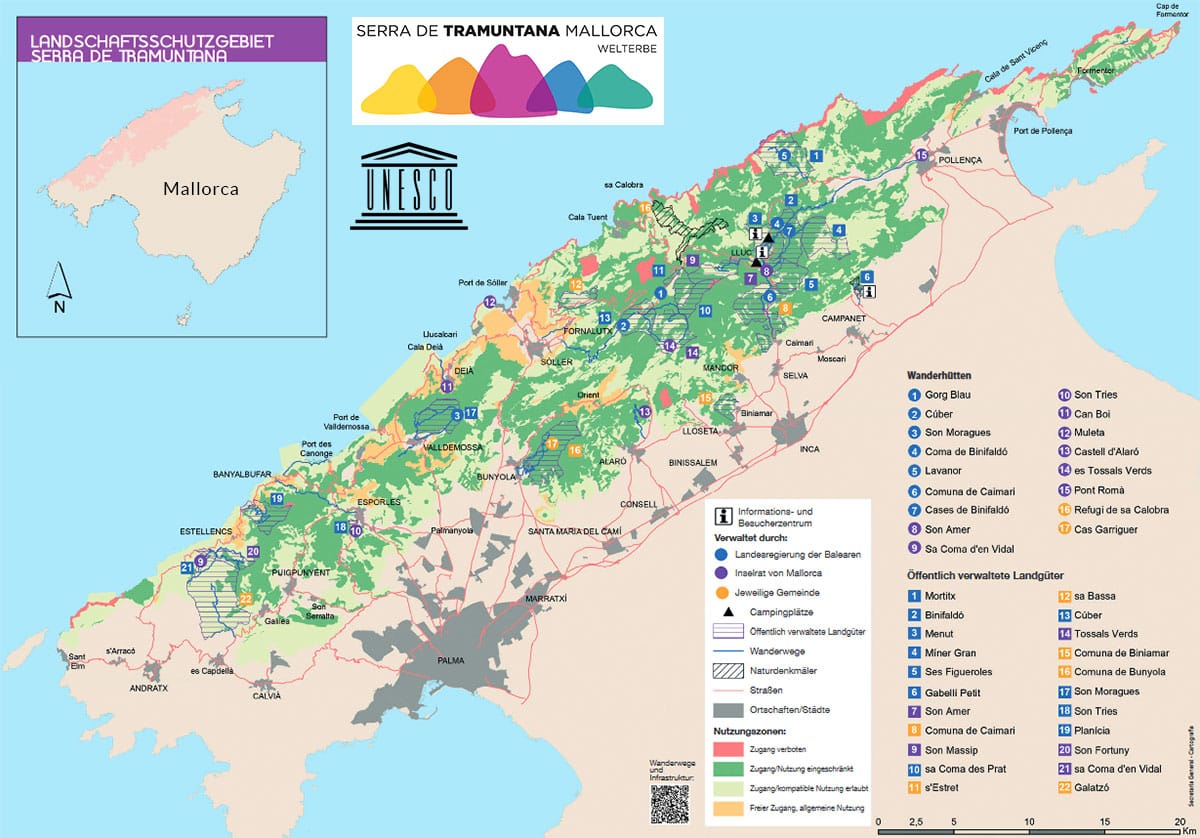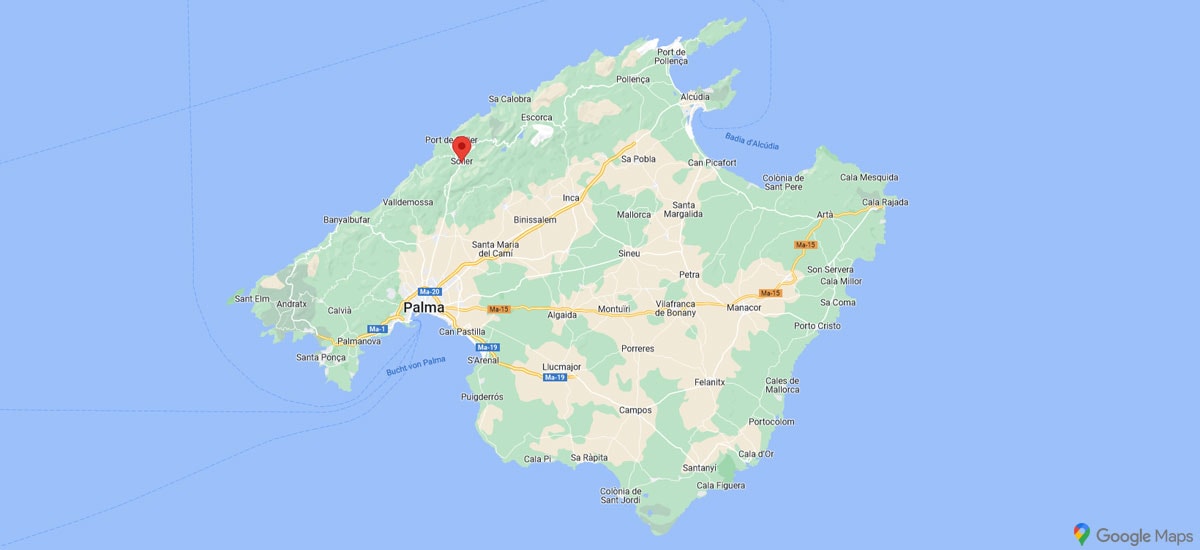The small town of Sóller is surrounded by the majestic and impressive mountains of the Serra de Tramuntana and is considered one of the most beautiful villages in Mallorca. Small streets, old stone houses, a majestic church, cozy cafes, small shops, a historic tram and the associated coastal town of Port de Sóller: Sóller is definitely worth a day trip.

Table of contents
The Serra de Tramuntana – A UNESCO World Heritage Site
Sóller is located in the Serra de Tramuntana area, which has been a UNESCO World Heritage Site in the cultural landscape category since 2011. This impressive mountain range, almost 90 kilometers long, is the largest protected area in the Balearic Islands and stretches from Andratx in the south-west to Cap Formentor in the north of the island. Over the millennia, a unique symbiosis of man and nature has developed here, which has left practically no damage to the landscape thanks to the particularly sustainable use of natural resources. Terraced fields, dry stone walls or cart tracks are not perceived as disturbing elements in the landscape, but as if they had arisen naturally from the mountains. In an area with little water, people have developed systems such as small dams, canals, reservoirs, basins and cisterns for the most efficient use of resources. And that is exactly what UNESCO took into account when making its World Heritage decision.
Worth knowing about Sóller in Mallorca
The small town of Sóller in the northwest of Mallorca has around 13,000 inhabitants and is nestled in an idyllic valley surrounded by the massive Tramuntana mountain ranges. Together with the municipalities of Fornalutx, Biniaraix and the port of Puerto de Sóller, Sóller lies in the idyllic “Golden Valley”, surrounded by some of the highest mountains on the island such as the 1,445 meter high Puig Mayor, the 1,093 meter high l’Ofre or the 1,064 meter high Mount Teix. Sóller became prosperous due to its fertile land and the abundant fruit and vegetable plantations and citrus fruits in the valley.
For a long time, the city was quite isolated from the rest of Mallorca and could only be reached via a long, sometimes dangerous mountain path. It was therefore much easier in those days to ship the harvested olives, almonds, oranges and lemons to France or Spain than to bring them to Palma overland. Only with the construction of the seven-kilometre-long country road over the “Coll de Sóller” pass (497 meters above sea level) and the railway line (Ferrocarril de Sóller) built in 1912 was Sóller directly connected to Palma. The old winding pass road meanders through the Tramuntana mountains in 57 curves. Today you can get to the city either by bus, train, ferry or by car. The capital Palma is around 34 kilometers away and Sóller is only around 30 minutes away by car via the MA-11 road and a 3,023 meter long tunnel.
Sóller is the starting point of various hiking routes through the mountains, along the coast and of course through “the charming valley of the oranges”.
Market Square, Town Hall & the Church of Sant Bartomeu
The central meeting point in the old town of Soller is the “Plaça de la Constitució”, where you will find some cozy cafes and bars. Here is also the parish church of Sant Bartomeu, the striking symbol of the valley. The church, which was built in 1236 and has been modified several times, is today mainly characterized by baroque decorations and stylistic elements. The front was redesigned from 1904 to 1912 and is in the style of Catalan Modernisme – the Catalan expression of Art Nouveau.
Also centrally located on the market square is the town hall, built in 1733, with the flags of Europe, Spain, Mallorca and Sóller attached to its balcony. The impressive city coat of arms integrated into the facade has found its place on the floor above.
The old town of Soller
On this beautiful day we walked a little through the narrow streets of the old town, which we really liked. Everything is a little more comfortable and quiet than, for example, in the capital Plama or S’Arenal. You should not miss the delicious ice cream – in the ice cream factory Fet a Soller directly opposite the market hall there is ice cream with milk and cream – and of course with the citrus fruits from the Sóllertal. ❤
The Ferrocarril de Sóller
One of the most popular rail routes in Mallorca for visitors to the island is the 27-kilometre journey between Palma and Sóller. For trips with these special wooden trains, there is even a small train station at Plaza Espanya in Palma, which is right next to another train station. For a price of EUR 25 per person return, you can enjoy a beautiful, nostalgic ride, crossing the Serra de Tramuntana mountain range through 13 tunnels, a 52-metre viaduct and numerous curves and bends.
Simultaneously with the construction of the Palma-Sóller railway line, a second line was built and later opened, which is served by a tram and runs from Sóller to the coastal town of Port de Sóller. For the 5 km long route you pay 7 EUR per person one-way. We would have loved to have driven this route, but unfortunately we didn’t make it due to time constraints.
The coastal town of Port de Sóller
If you’re already in Soller, you shouldn’t miss out on visiting the small coastal town of Port de Sóller. The sheltered port on the approximately 80 km long northwest coast of Mallorca is only about 3 kilometers from the main town of Sóller and is easily accessible via the MA-11 state road, by bus or the tram connection established in 1913.
The port of Sóller is the largest on the northwest coast of Mallorca. There are two beaches (Playa de’n Repic and Playa des Través), one on each side of the bay. The tram runs right along the beach.


